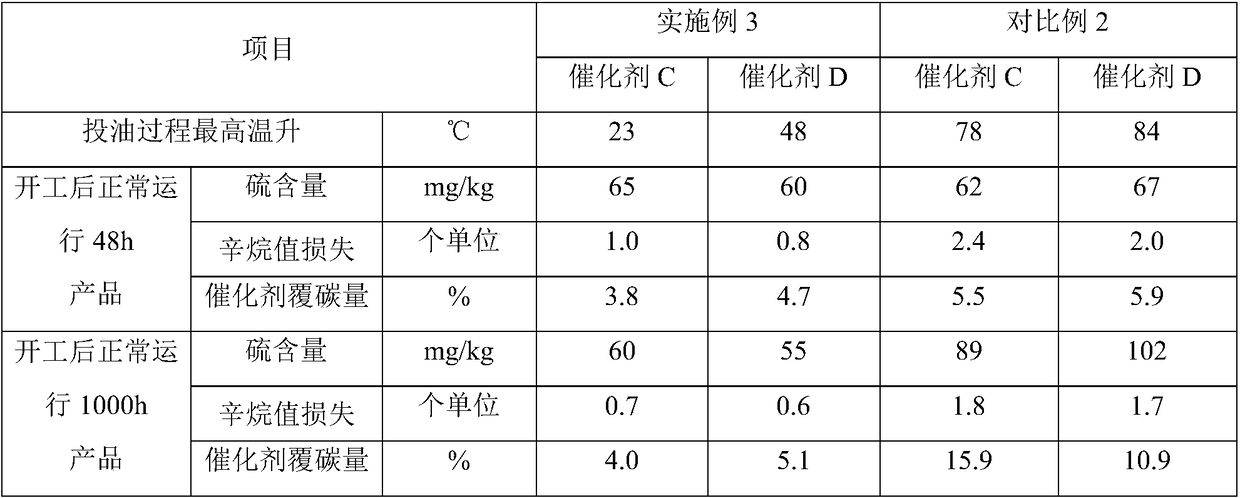A passivation start-up method for gasoline hydro-upgrading catalyst containing molecular sieve
A gasoline hydrogenation and hydrogenation upgrading technology, which is applied in the fields of hydrogenation treatment process, petroleum industry, hydrocarbon oil treatment, etc., can solve the problems of unusable passivation and difficulty in ensuring the stability of catalyst activity, etc., so as to improve stability, The effect of avoiding the loss of catalyst activity
- Summary
- Abstract
- Description
- Claims
- Application Information
AI Technical Summary
Problems solved by technology
Method used
Image
Examples
Embodiment 1
[0023]Apply gasoline hydro-upgrading catalyst A to a 400,000-ton / year FCC gasoline hydrogenation unit. After catalyst sulfuration treatment, reduce the inlet temperature of the hydro-upgrading reactor to 260°C. 21t / h, hydrorefined oil flow rate 26t / h, FCC gasoline and hydrorefined oil are introduced into the reaction system at the same time, and the system sends out 47t / h of products; increase the inlet temperature of the reactor at 20°C / h, Until the inlet temperature of the reactor reaches 310°C;
[0024] Reduce the inlet temperature of the hydro-upgrading reactor to 300°C, and introduce the catalytic cracking gasoline and hydro-refined oil into the reaction system at the same time according to the feed flow rate of catalytic cracking gasoline of 33t / h and the flow rate of hydro-refined oil product of 14t / h. At the same time, the system sends out 47t / h of products; increase the inlet temperature of the reactor at 8°C / h until the inlet temperature of the reactor reaches 340°C;...
Embodiment 2
[0029] Pack 500ml of gasoline hydro-upgrading catalyst A into a 500ml adiabatic bed hydrogenation reactor. After the catalyst is vulcanized, the inlet temperature of the reactor is lowered to 250°C, and naphtha containing 35wt% FCC gasoline is introduced into the reaction system; increase the inlet temperature of the reactor at a heating rate of 3°C / h until the inlet temperature of the reactor reaches 315°C;
[0030] The inlet temperature of the reactor was lowered to 300°C, and naphtha containing 62wt% FCC gasoline was introduced into the reaction system; the inlet temperature of the reactor was increased by 3°C / h until the inlet temperature of the reactor reached 340°C;
[0031] Reduce the inlet temperature of the reactor to 320°C, and introduce 100wt% catalytically cracked gasoline raw material into the reaction system; increase the inlet temperature of the reactor at 3°C / h until the inlet temperature of the reactor reaches 370°C, and the passivation process ends. During th...
Embodiment 3
[0040] Pack 500ml of gasoline hydro-upgrading catalyst C into a 500ml adiabatic bed hydrogenation reactor. After the catalyst is vulcanized, the inlet temperature of the reactor is lowered to 230°C, and the catalytic reformed oil containing 41wt% coked gasoline is simultaneously introduced into the reaction System; increase the inlet temperature of the reactor at 10°C / h until the inlet temperature of the reactor reaches 310°C;
[0041] Reduce the inlet temperature of the reactor to 285°C, introduce catalytic reformed oil containing 65wt% coker gasoline into the reaction system; increase the inlet temperature of the reactor at 5°C / h until the inlet temperature of the reactor reaches 340°C;
[0042] Reduce the inlet temperature of the reactor to 315°C, introduce 100wt% coked gasoline raw material into the reaction system; increase the inlet temperature of the reactor at 5°C / h until the inlet temperature of the reactor reaches 360°C; the passivation process ends. During the passi...
PUM
 Login to View More
Login to View More Abstract
Description
Claims
Application Information
 Login to View More
Login to View More - R&D
- Intellectual Property
- Life Sciences
- Materials
- Tech Scout
- Unparalleled Data Quality
- Higher Quality Content
- 60% Fewer Hallucinations
Browse by: Latest US Patents, China's latest patents, Technical Efficacy Thesaurus, Application Domain, Technology Topic, Popular Technical Reports.
© 2025 PatSnap. All rights reserved.Legal|Privacy policy|Modern Slavery Act Transparency Statement|Sitemap|About US| Contact US: help@patsnap.com



